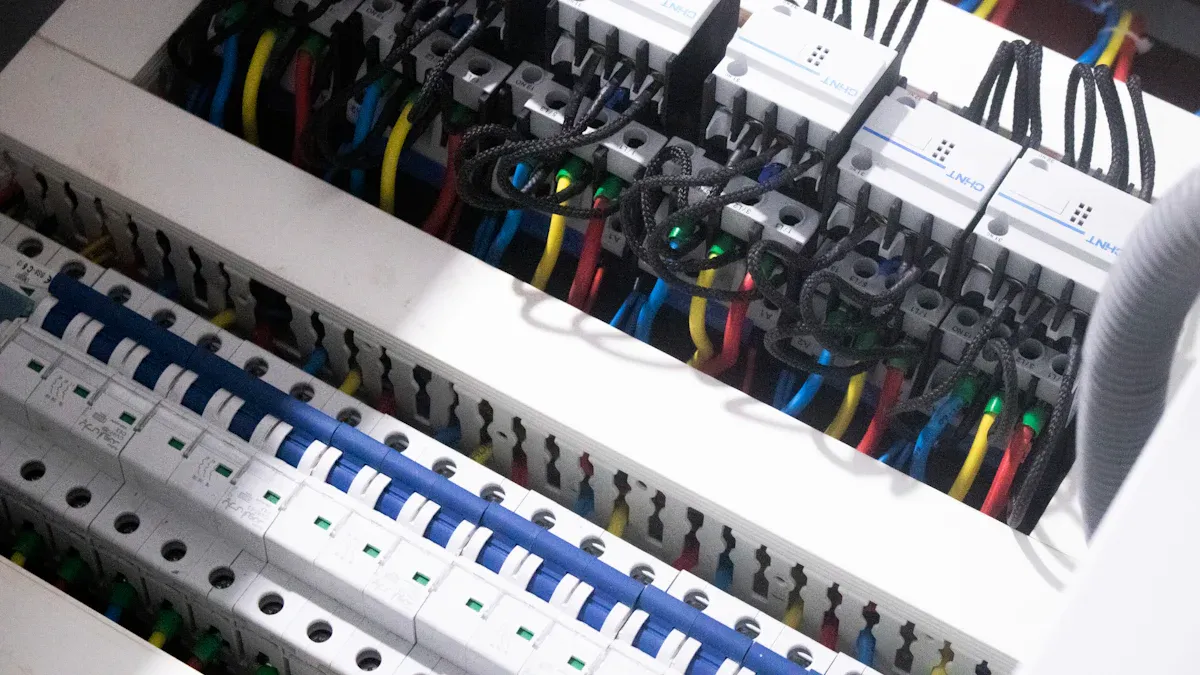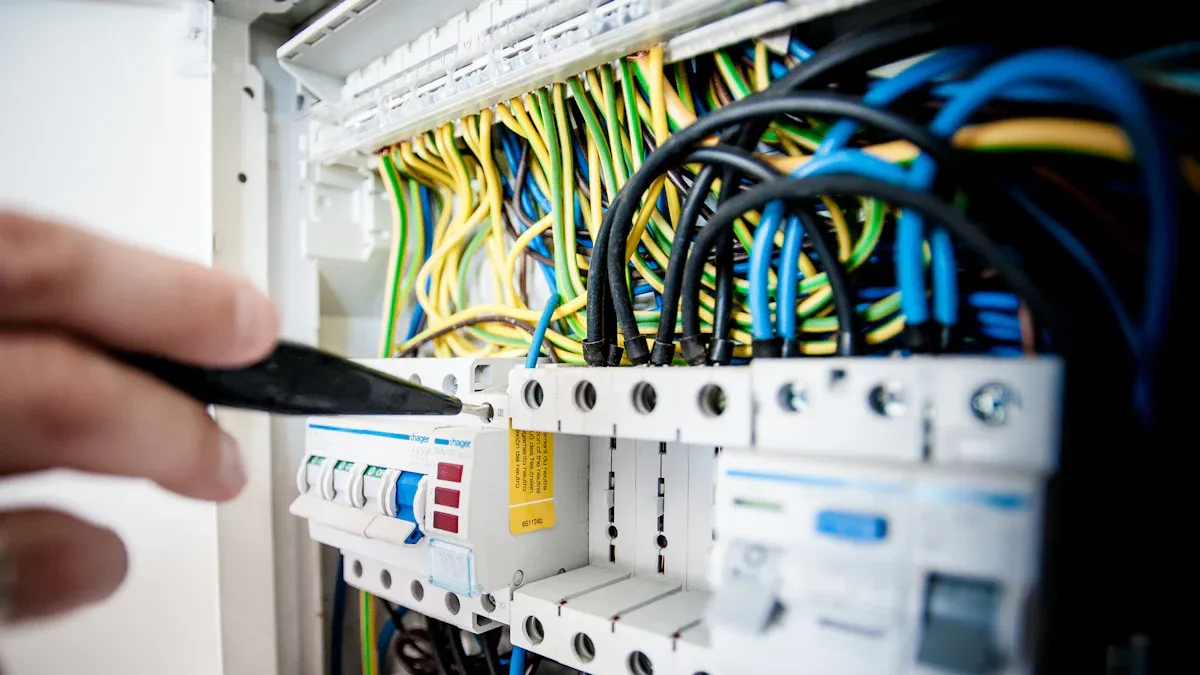
Views: 0 Author: Site Editor Publish Time: 2025-08-04 Origin: Site

You want to keep your home and work safe from electrical dangers. Picking the right device is important. An RCBO gives overcurrent and leakage protection. It is helpful in places where time is important, like hospitals. An RCCB, or Residual Current Circuit Breaker, finds small leakage currents. This helps stop electric shocks and fires. A GFCI protects you by cutting power fast if it finds a ground fault. This keeps people safer in kitchens and bathrooms. These devices make things safer by stopping dangerous faults quickly. They help you avoid getting hurt and protect your property.
RCBO gives both overcurrent and earth leakage protection in one device. This makes it great for safety at home and work.
RCCB only protects against earth leakage. It works best with another breaker for overloads. It is good for wet places.
GFCI shuts off power fast if it finds ground faults. It keeps people safe in kitchens, bathrooms, and outside.
Test your safety devices every month with the test button. This helps make sure they work right. Change any broken units.
Pick the right device for your place and safety needs. Follow local electrical rules. Ask a licensed electrician to install it.

An RCBO has two main safety features in one device. It gives both overcurrent and earth leakage protection. The RCBO works like a breaker and checks the electricity flow. If it finds a problem, it shuts off the circuit fast. This quick step helps stop electric shocks and fire risks. The RCBO follows rules like IEC and NEC, which need ground fault protection in many places. The RCBO uses ideas from both an MCB and an RCCB. You do not need two devices. You get both protections in one small unit.
You trust the RCBO to keep your electrical system safe. It protects against overloads, short circuits, and earth leakage. If you plug in too many things or a wire breaks, the RCBO finds the danger. It turns off the circuit before anything bad happens. This keeps you safe from electric shocks and lowers fire risk. The RCBO also helps keep your appliances safe from electrical problems.
You can use an RCBO in lots of places. It works in homes, offices, hospitals, and factories. RCBOs are common where safety matters most, like kitchens, bathrooms, and workshops. The RCBO fits in most new electrical panels. You can put it in for one circuit or for many circuits that need more protection. Many people pick RCBOs for new buildings because they give full protection in one device.
Tip: Picking an RCBO helps you feel safe because you get both overcurrent and leakage protection in one breaker.
Pros:
Gives two kinds of protection for your circuit.
Saves space in your panel.
Acts fast when there is a problem.
Follows world safety rules.
Cons:
Costs more than a normal breaker or RCCB.
Might need a pro to install.
A residual current circuit breaker helps keep you safe from electrical leaks. The RCCB checks if the current in the live and neutral wires is the same. Inside, a core transformer wraps around both wires. When both wires carry equal current, everything is balanced. If electricity leaks out, like through a person or a broken wire, the balance is lost. The RCCB notices this change. If the difference is more than a set amount, like 30mA, it shuts off the circuit. This happens very fast to stop shocks and fires. HAIPART makes RCCBs that follow IEC 61009 rules. These devices use smart circuits and switches for quick and safe protection.
You use an RCCB to guard against earth leakage and ground faults. It can find small leaks, even as low as 6mA, and turn off the power in less than 30 milliseconds. This quick action helps stop shocks and lowers fire risk. An RCCB does not protect against overloads or short circuits. You need another breaker or fuse for those problems. The RCCB is made to stop leaks, so it is important for safety, especially in wet places like bathrooms and kitchens. You should test your RCCB often to make sure it works well.
You can put RCCBs in many places. They work in homes, offices, schools, and factories. People use them where water is around, like laundry rooms and outside outlets, because shocks are more likely there. HAIPART has RCCBs for homes and for big buildings. For example, HAI-RCCB-1PN40 is good for houses, and HAI-RCCB-3PN20 is for bigger jobs. These RCCBs have fire-safe cases and easy test buttons, so they are safe and simple to use.
Note: An RCCB gives strong earth leakage protection but does not stop overcurrent.
Pros:
Gives fast protection from shocks and ground faults.
Has a simple design and is easy to put in.
Costs less than RCBOs.
Follows world safety rules.
Cons:
Does not stop overloads or short circuits.
Needs another breaker for full protection.
Feature/Aspect | RCCB (Residual Current Circuit Breaker) | RCBO (Residual Current Breaker with Overcurrent Protection) |
|---|---|---|
Protection Type | Earth leakage (residual current) protection only | Earth leakage + overcurrent (overload and short circuit) protection |
Overcurrent Protection | Not provided; needs separate MCB | Built-in overcurrent protection |
Cost | Lower initial cost | Higher initial cost |
Installation Space | Less space needed | More space needed |
Application | Good for basic protection, needs extra devices | Best for full protection in one device |
You pick an RCCB when you want strong earth leakage protection and a simple setup. If you want both leakage and overcurrent protection in one, you might choose an RCBO.

You use a gfci to keep yourself safe from dangerous faults in your electrical system. The gfci stands for ground fault circuit interrupter. This device checks the flow of electricity in a circuit. If the gfci finds that the current leaving the circuit does not match the current returning, it acts fast. The gfci will cut off the power in less than a second. You can find gfci outlets and gfci breakers in many homes and buildings. The gfci works by sensing small changes in the current. Even a tiny leak can make the gfci trip. This quick action helps stop electric shocks and keeps you safe.
A gfci gives you strong protection against ground faults. The gfci does not protect against overloads or short circuits, but it does stop dangerous leaks. You can trust a gfci to protect you in places where water is near, like bathrooms and kitchens. The gfci will trip if it senses a problem, so you do not get hurt. You should test your gfci often to make sure it works. The gfci is a key part of your home’s safety plan. It helps prevent electric shocks and can even save lives.
Tip: Always press the test button on your gfci every month to check if it works.
You can use a gfci in many places. Most building codes require a gfci in bathrooms, kitchens, garages, and outdoor outlets. You will also see gfci devices in schools, hospitals, and offices. The gfci is important in places where water and electricity might mix. You can install a gfci outlet or a gfci breaker in your main panel. Some people use portable gfci units for tools and outdoor work. The gfci keeps you safe wherever you need extra protection.
Here are some common uses for a gfci:
Bathrooms and kitchens
Laundry rooms
Outdoor outlets
Pools and spas
Garages and basements
Note: A gfci is easy to use and gives you fast protection, but it does not replace a regular breaker for overloads.
Pros:
Gives fast protection from ground faults
Easy to install and test
Helps prevent electric shocks
Required by many safety codes
Cons:
Does not protect against overloads or short circuits
May trip if there is a small leak or moisture
Feature | GFCI Outlet | GFCI Breaker |
|---|---|---|
Where to Use | Single outlets | Whole circuits |
Reset Location | At the outlet | At the panel |
Main Benefit | Local protection | Circuit protection |
When you pick between a gfci, a residual current circuit breaker, or an rcbo, you should know how they are not the same. Each device keeps you safe, but they do it in different ways. The main differences are in how they protect you, how well they notice leaks, where you use them, and how you put them in.
You want strong protection for your house or business. Each device protects you in its own way. A gfci keeps you safe from ground faults. It shuts off power if it finds a leak. People use a gfci in wet places, like kitchens or bathrooms. A residual current circuit breaker also stops electric shocks. It looks for leaks in the current, just like a gfci does. The rcbo gives you even more safety. It works like a gfci and a breaker together. You get protection from ground faults, too many devices, and short circuits. You only need one device for all these problems.
Tip: Pick the device that gives you the right protection. If you want ground fault and overcurrent safety, choose an rcbo.
Sensitivity means how small a leak the device can find. This helps you pick the best one for your needs. A gfci can find very tiny leaks, even as low as 5mA. This high sensitivity helps stop shocks. A residual current circuit breaker is also very sensitive. Many trip at 30mA, but some can find even smaller leaks. The rcbo is just as sensitive. It gives you high sensitivity and extra safety from overloads. These devices act fast when they sense danger.
You will see these devices used in different places. In the United States, most homes have gfci outlets and breakers. Building rules say you must use gfci in bathrooms, kitchens, and outside. In Europe and Asia, people use more residual current circuit breaker and rcbo devices. These places have different wiring, so they need other types of safety. Some countries want a residual current circuit breaker on every circuit. Others use rcbo for full safety. Always check your local rules before you buy.
Note: Your area may need a gfci, a residual current circuit breaker, or an rcbo. Always follow the rules where you live.
There are differences in how you put in these devices. A gfci outlet takes the place of a normal wall outlet. You can put it in yourself if you follow the steps. A gfci breaker goes in your main panel. You might need an electrician for this. A residual current circuit breaker fits in your breaker box. You can use it for one circuit or the whole panel. The rcbo also goes in the panel. It saves space because it does two jobs. Always test your device after you put it in. Press the test button to check if it works.
Device Type | Where to Install | Who Installs It | Test Button |
|---|---|---|---|
gfci outlet | Wall outlet | Homeowner/Electrician | Yes |
gfci breaker | Main panel | Electrician | Yes |
residual current circuit breaker | Breaker box | Electrician | Yes |
rcbo | Breaker box | Electrician | Yes |
��️ Always turn off the power before you put in any device. Safety is the most important thing.
Think about where you will use your protection device. At home, you want to keep your family safe from electric shocks. Places like bathrooms, kitchens, and outside outlets are more risky. You need a device that acts fast if something goes wrong. In commercial places, you must protect people and equipment. Offices, shops, and factories use bigger machines. Here, you need a device that stops overcurrent, short circuits, and leakage.
Here is a table to help you compare your choices:
Factor | Safety Switch (RCCB/GFCI) | Circuit Breaker (RCBO) |
|---|---|---|
Protection Type | Detects electrical leakage to protect people | Protects against overcurrent and short circuits |
Primary Use | Personal safety, especially in high shock risk areas (bathrooms, kitchens) | Equipment and wiring protection |
Response Speed | Instant power cut-off upon detecting leakage | Trips power on overload or short circuit |
Application Areas | Areas with higher shock risk, outdoor outlets | Residential and commercial electrical panels |
Cost Considerations | Generally more cost-effective | Higher cost due to combined protection functions |
Installation & Space | Easier installation, less space required | Requires more installation space and wiring complexity |
The table shows you should pick what fits your needs. For personal safety in risky spots, a safety switch like an RCCB or GFCI is a good pick. For full protection, including equipment, an RCBO is a strong choice.
You have to follow local safety rules. In the United States, GFCI outlets are used in bathrooms and kitchens. Building codes often require them. In Europe and Asia, RCCBs and RCBOs are more common. These places often want protection on every circuit. Always check your country’s rules before you buy or put in a device. This keeps you safe and helps you pass inspections.
Tip: Ask a licensed electrician for advice about the best device for your area. They know the newest safety codes.
You can stay safer by doing a few easy things:
Test your devices every month. Press the test button to see if they work.
Change any device that does not trip when tested.
Keep water away from outlets and cords.
Do not overload a circuit.
Teach your family about electrical safety.
Remember, the right device and good habits keep you safe. Your safety is most important, at home or at work.
If you want to know how RCBO, RCCB, and gfci are different, this table can help. It lets you compare them fast. Use this chart to help you pick the best protection for your house or work.
Feature | RCBO | RCCB | GFCI |
|---|---|---|---|
Full Name | Residual Current Breaker with Overcurrent Protection | Ground Fault Circuit Interrupter | |
Main Protection | Overcurrent + Earth Leakage | Earth Leakage Only | Ground Fault Only |
Overcurrent Protection | Yes | No | No |
Earth Leakage Protection | Yes | Yes | Yes |
Typical Sensitivity | 10-30mA | 6-100mA | 5-6mA |
Common Use | Homes, offices, factories | Homes, commercial, industry | Bathrooms, kitchens, outdoor |
Installation | Breaker panel | Breaker panel | Outlet or breaker panel |
Test Button | Yes | Yes | Yes |
Cost | Higher | Medium | Lower |
Space Needed | Less (combined device) | More (needs extra breaker) | Outlet or panel space |
Regional Use | Europe, Asia | Europe, Asia | United States, Canada |
Tip: Always look at your local rules before you buy a device. Some places want a gfci in some rooms. Other places use RCCB or RCBO for the whole panel.
This table helps you find what you need. Pick RCBO if you want both overcurrent and leakage protection. RCCB is good if you already have a breaker for overcurrent. If you need quick ground fault safety in wet spots, gfci is often best.
You now know the main differences between RCBO, RCCB, and GFCI. Each device helps you improve safety in your home or business. Choose the right one to match your needs and follow local rules. Always test your device to make sure it works. For the best safety, ask a licensed electrician for help with installation or advice.
You get earth leakage protection from an RCCB. An RCBO gives you both earth leakage and overcurrent protection. If you want full safety in one device, you should choose an RCBO.
You can use a GFCI for ground fault protection in the United States. In other regions, you may need an RCCB. Always check your local electrical codes before you decide.
You should test your RCCB, RCBO, or GFCI every month. Press the test button to make sure the device works. If it does not trip, you need to replace it.
You should install these devices in places with higher shock risk. Bathrooms, kitchens, laundry rooms, and outdoor outlets need extra protection. For full home safety, use them in your main panel.
Tip: Always ask a licensed electrician if you feel unsure about installation or safety.